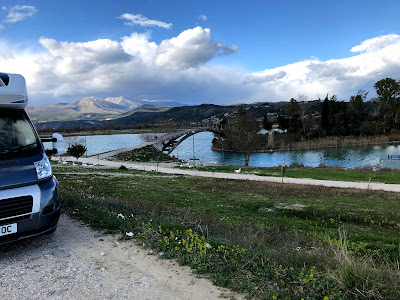Lady Caroline Lamb, one of his many lovers, described him as 'mad, bad and dangerous to know'. He was a spendthrift and serial seducer who wrote some of England's best known poetry. When he died Westminster Abbey refused to give him burial because of his 'questionable morality', and it was 145 years before a plaque in his honour was placed in Poets' Corner. To the Greeks however, Lord Byron is a hero for his part in their struggle to throw off the yoke of the Ottoman Empire. That is why we found ourselves standing in front of his towering statue in the Garden of Heroes situated in the town of Messolonghi.
 |
| Legend says his heart is buried here |
Byron had arrived in Greece with a fortune, having sold his English estate, and he intended to spend it on helping in the Greek War of Independence. Despite having no military experience, he raised and equipped a regiment which he proposed to lead as part of a Greek assault on the Turkish-held town of Lepanto. However he contracted a fever which his doctor tried to assuage by bloodletting. Unfortunately the instruments used were infected and Byron died of sepsis on 19th April 1824, a day commemorated as Byron Day in Greece. His heart was removed and, according to legend, lies beneath his statue in Messolonghi. The rest of him was embalmed and shipped back to the family vault in Nottinghamshire where he lies alongside his only legitimate child, Ada, Countess of Lovelace, who was a pioneer in the development of the computer.
 |
| The Greek version of MDCCCXXXVIII |
 |
| Saying goodbye to the Peloponnese |
Wednesday afternoon saw us in the small town of Amfilochia, set at the head of a large sea inlet where we found ourselves a spot down by the quay. As luck would have it, we had a second disturbed night. It seemed that, after midnight, someone was prowling round the van but got shouted at by some fishermen and shot off on a moped. All this excitement disturbed Max who insisted on going out for a pee in the small hours. Just as we got back to sleep, some of the local cats started shouting at each other, something guaranteed to get Elsa barking. We woke late on Thursday morning to the sound of rain beating down on the roof.
 |
| Elsa's turn to drive |
We had been keeping an eye on the sea state forecast in the Adriatic in order to get as calm a voyage as possible to Brindisi. We decided that next Monday night looked the most promising so we finally booked our passage for the eight hour crossing leaving Igoumenitsa at midnight. They offer pet friendly cabins so we will be able to have the spaniels in the cabin with us, rather than down on the car deck in the van.
The landscape changed dramatically as we headed further north. We were now in the wetter west coast of Greece and the countryside was much more lush than we were used to. The number of olive groves diminished to be replaced by pasture and crops. However, there were still some orange trees about so we were able to stop at a roadside stall and get 5 kilos of juicy oranges for €2. We arrived at our overnight stop, looking down on a lake outside the city of Arta. We share the spot with a large number of waterfowl, including geese. Hopefully, any attempt to mess about with the van tonight will be thwarted as they emulate the sacred geese of Rome who warned of an attack by Gauls on the city's Capitoline Hill in 390 BC. They look vicious enough.
 |
| Looking down on the geese |



I'm glad that Greece has a version of Waitrose.
ReplyDeleteNot sure if they're all like that, but when we got the ferry with Sergei from Igoumenitsa it was an inside cabin which was a bit claustrophobic. Still great to have him with us tho, unlike the Shetland-Aberdeen trip. Happy sailing!
ReplyDeleteThe things we learn from your travel log. I’m pleased to know more about Lord Byron.
ReplyDelete